Mary Anne Yarde's Blog: The Coffee Pot Book Club , page 130
July 11, 2019
Author,Ian Nathaniel Cohen explains how he wrote non-historical sword fights into his fabulous book — The Brotherhood of the Black Flag #amwriting #HistoricalFiction @INCspotlight
In Like FlynningWriting Non-Historical Sword Fights in my Historical FictionBy Ian Nathaniel Cohen
 Jean Leon Jerome Ferris, Capture of the Pirate, Blackbeard, 1718.
Jean Leon Jerome Ferris, Capture of the Pirate, Blackbeard, 1718.When writing historical fiction, there's always a hazy line between accuracy and artistic license. As writers, our job is to tell a captivating story that can maintain a reader's interest, not show off how much research we've done. On the other hand, what we come up with has to be at least somewhat credible, especially to audiences familiar with the time period we're writing about. That means having to do a truckload of research to get all sorts of details right, not for its own sake, but to understand how the setting would most likely impact our characters in one way or another. (And, of course, to avoid the inevitable - and to be fair, justified - wrath of fact-checkers.)
My first novel, The Brotherhood of the Black Flag, is an adventure thriller set in the Golden Age of Piracy, an era that fortunately is easy to find information about. When doing my research, I not only scoured books, articles, and websites, but also fired off emails to academics, government officials, and re-enactment societies asking for all manner of information so I could depict the time period as accurately as possible and understand how it could possibly shape the plot and character arcs. I've been going through that same process for my next book, The Sherwood Caper, a heist thriller set in Medieval England – and yes, it’s about Robin Hood. I’ve been fact-checking the accuracy of the terminology I use, poring over maps to make sure I have my geography straight, that sort of thing - and that's just the non-spoilerish stuff.
 Matthias Stom, Young Man Reading by Candlelight.
Matthias Stom, Young Man Reading by Candlelight. However, there's one part of my writing where I willfully, deliberately, and unapologetically chuck strict historical accuracy out the window - sword fight choreography.
The job of every scene in a book is to paint a vivid picture for the reader, allowing them to visualize the proceedings like they're watching it on a screen. When I write sword fights, the picture I typically want to paint is two opponents engaging in a graceful, fast-paced clash of blades, like something from an Errol Flynn movie or The Princess Bride. There’s even a semi-official term for this theatrical kind of swordplay, according to TV Tropes – “Flynning.”
 John Leech, The Battle of Bosworth Field: A Scene from the Great Drama of History.
John Leech, The Battle of Bosworth Field: A Scene from the Great Drama of History.A real fight, of course, is nothing like this. They're a messy tangle of limbs and weapons, where the objective is to take down your opponent as quickly as possible by any means necessary, fair play be damned. If you want to read great examples of these kinds of fight scenes in historical fiction, Bernard Cornwell's Sharpe novels and Arturo Pérez-Reverte's Alatriste series are loaded with them.
As for real fencing, it's all about economy of movement so you can attack and defend as quickly and efficiently as possible. The moves in stage and screen combat, however, are flashy and exaggerated to look more exciting.
 Jacques Callot, The Duel with the Sword and Dagger
Jacques Callot, The Duel with the Sword and DaggerSo why did I go this route? If I’m determined to be a stickler for accuracy in all other respects, why make an exception for how I stage my sword fights?
I have two main reasons for doing this. The first is a stylistic choice. I grew up on Hollywood swashbucklers, and both The Brotherhood of the Black Flag and The Sherwood Caper are intended, among other things, as homages to these movies. A key part of capturing the spirit of this genre is trying to replicate the feel of their fight scenes, even if it comes at the expense of the accuracy I aim for elsewhere in the story.
The other reason is simply that those are the kinds of fight scenes that, in part, inspired my writing. Film fights may be anachronistic and unrealistic, but in the context of certain kinds of stories, they're a lot more fun to watch. The movements are more fluid, the pacing is faster, and the choreography is more graceful. It's a thing of beauty to watch a fight like that, and I wanted to see as much of these as I could.
 Percy MacQuoid, Types of Swordsmanship – II: The Sword and Dagger Due
Percy MacQuoid, Types of Swordsmanship – II: The Sword and Dagger DueAs a result, cinematic swordsmanship ended up becoming a gateway to a variety of fiction genres across all mediums, as well as multiple eras of world history that inspired the fiction, where I could see and read about as many sword fights as possible. All this inspired not only a fascination with fencing, which I took for six years, but also stage combat and fight choreography, which I've had a few lessons in - not to mention trying my hand at my own stories about sword-swinging heroes. Long story short, the Flynning style of screen fighting was what inspired me not only as a reader, but as a writer, so that's what I try and reproduce in my work.
That doesn't mean I don't do any research whatsoever when coming up with my fights. I still need to learn about the weapons being used and how they are best used, as well as how to depict proper and improper stance. (The protagonist of The Brotherhood of the Black Flag is a former fencing instructor, requiring him to not only demonstrate proper form and technique himself, but correct students as needed.)
 Johann Georg Puschner, The Fencing Student.
Johann Georg Puschner, The Fencing Student.Beyond that, characters using certain moves and techniques are textbook examples of "show, don't tell" when it comes to demonstrating their proficiency with a particular weapon or fighting style. As an example, for one of the duels in The Brotherhood of the Black Flag, there's a sword fight that originally ended with one character disarming another with a vaguely described move. More than one beta reader wanted to "see" what the actual move was. As the victor was armed with a schiavona, a cut-and-thrust sword with a distinctive fighting style, I consulted with a friend who's knowledgeable about that particular weapon. (In fact, it was thanks to him that I decided said character was even going to use one.) He told me about using the cage-like handguard of the schiavona's hilt to trap the opponent's blade and pull the sword out of their hand. It's a very difficult move that requires a great deal of expertise to pull off, and having a character use it demonstrates that expertise, instead of me having to say “this guy’s an expert.”
 Jacques Callot, The Duel With Swords.
Jacques Callot, The Duel With Swords.Also, even with this approach to how I stage my fights, I still have to follow the rules of "show, don't tell" in other ways. Readers don't want to see a detailed blow-by-blow account of a duel to the death, because they're boring to read - and frankly, boring to write. Instead, we want to know what's going on inside the combatant's heads. Are they afraid? Is rage clouding their judgment? Do they feel a kind of thrill at facing off against someone who can give them a good challenge? That's what readers want us writers to show them, and that's what I try and focus on.
Will I ever write more realistic fight scenes at any point? Yeah, probably, for a story that calls for it - something with a more dramatic flavor to it, rather than a lighthearted swashbuckling adventure story. But for now, rather than Capo Ferro, Thibault, and Agrippa, I'll look to Fred Cavens, Bob Anderson, and F. Braun McAsh for my sword fights.
 Henry Gilbert, Robin Hood and Guy of Gisborne.
Henry Gilbert, Robin Hood and Guy of Gisborne.The Brotherhood of the Black FlagBy Ian Nathaniel Cohen

Thrills, treachery, and high-seas swashbuckling adventure await in the Golden Age of Piracy's final reckoning!
His once-promising naval career in tatters, Michael McNamara leaves the newly-United Kingdom behind in search of a new life. With no other skills but the sword, he joins forces with a pirate turned pirate hunter, determined to rid the Caribbean of the Brotherhood of the Black Flag once and for all.
Eager for a worthy cause to fight for, McNamara pits himself against treacherous seas and battle-hardened buccaneers... and uncovers an international conspiracy that threatens the lives of thousands.
"Cohen delivers a solid, compelling, and briskly paced story that blends adventure and romance within a rich historical setting."
The BookLife Prize
Pick up your copy ofThe Brotherhood of the Black FlagAmazon UK • Amazon US • Barnes and Noble • Kobo
Ian Nathaniel CohenIan Nathaniel Cohen is a native of Miami, Florida, where he grew up immersing himself in swashbuckler literature and film. He graduated from the University of Central Florida in 2003 with a BA in Radio/Television Production and a Minor's Certificate in Applied Computer Science. He also received his MA in Asian Studies from Florida International University in 2006, where he teaches the course Asia Through Film as an adjunct lecturer. In 2010, his essay "Heroes & Villains of the East", analyzing the evolving depiction of the Japanese in Chinese and Hong Kong martial arts cinema, was published in FIU's Japan Studies Journal.
He also writes a review blog, the INCspotlight, focusing on classic films, comic books, and video games.
Connect with Ian: Twitter • Goodreads.
Published on July 11, 2019 20:00
July 10, 2019
Join Historical Fiction author, Richard J. Koreto, as he takes a look at Scotland Yard's Storied History #History #ScotlandYard @RJKoreto
Scotland Yard's Storied HistoryBy Richard J. Koreto
Even those who have never been to England have heard of the famed London police force known colloquially as "Scotland Yard." Its fictional exploits in novels, movies and TV shows may actually outnumber its real achievements—as impressive as they are. But its history is more astonishing then the stories written about them.
London's Police Force Was Established by a Novelist and His Blind Brother
London was a large and thriving city in the 18th century. It was also a dangerous one. Private thief-catchers and disorganized watchmen were all the city had for law enforcement. But there was little appetite for a formal government police force. Freedom-minded Englishmen thought a government-sponsored agency would lead to tyranny.
Still, something had to be done to curb crime, and Henry Fielding, the magistrate of London's Bow Street Court, put his mind to it. He was a man of great imagination—not only a magistrate, but a distinguished writer, who practically invented the English novel. He is best remembered today as the author of "Tom Jones."
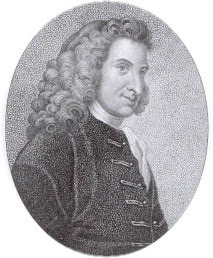
This is a portrait of Henry Fielding, magistrate and author.
He created a group of law officers who answered to him as magistrate. They came to be known as the Bow Street Runners. This was the first time England had professional law officers, paid for by the government, and they were a success. After Fielding died, he was succeeded by his brother, John Fielding. Although John had been blinded in an accident as a young man, he still manage to educate himself. John Fielding continued his brother's work in developing law enforcement and was eventually knighted for his achievements.
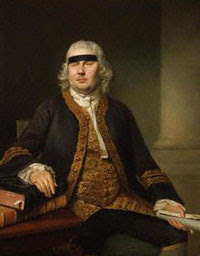 This is a portrait of Sir John Fielding, a magistrate, although blind.
This is a portrait of Sir John Fielding, a magistrate, although blind.Scotland Yard—Which Has Nothing to Do with ScotlandHowever, London continued to grow, and as England moved into the 19th century, it became clear a more sophisticated, national solution was needed. Sir Robert Peel, a member of Parliament who eventually became prime minister, thought the time was right to establish a formal police force in London—which would be a model for other cities to follow.
Fortunately, Peel was a shrewd lawyer, and did everything to soothe an anxious public that feared a national police force would become the tool of an oppressive government. They thought about France: the public there viewed the police as enforcers for a series of dictatorial rulers. Anyone who read Les Misérables or seen any of the many dramatizations understands that Englishmen did not want a country full of Inspector Javerts!

Sir Robert Peel, a leading Victorian statesman and founder of the modern British police force.
First, Peel made sure the senior officers of the new police force would bear civilian titles, not military ranks: instead of colonels there would be superintendents. Instead of a general running the show there would be a commissioner. He also made sure that the new officers would not be wearing military uniforms. Indeed, the first constables, as they were called, wore top hats! And they carried batons, or truncheons, not swords and guns.
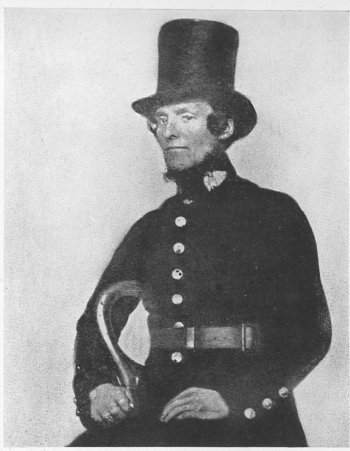 Here's what the early constables looked like. They originally wore top hats—the iconic helmets came later.
Here's what the early constables looked like. They originally wore top hats—the iconic helmets came later.A New Way of Policing: Cooperation Rather Than Fear
Peel established their headquarters on the grounds of what had long ago been the Scottish embassy in London—hence the name Scotland Yard. Although it's moved from its original location, it's still casually referred to as Scotland Yard. Another nickname is the Met, from its official name, the Metropolitan Police Service.
 Here I am in front of the current Scotland Yard building.
Here I am in front of the current Scotland Yard building.As Peel explained it, the police were just citizens paid to help out with law and order. He said their purpose would be "to maintain at all times a relationship with the public that gives reality to the historic tradition that the police are the public and that the public are the police, the police being only members of the public who are paid to give full-time attention to duties which are incumbent on every citizen in the interests of community welfare and existence."
Or, as historians have put it, Scotland Yard became the first police force based on cooperation rather than fear.
Gradually, and with increasing enthusiasm, the public welcomed the new police force, in London and other cities. The constables were called "Bobbies" in honor of Robert Peel, a nickname they retain.
 Here I am in front of the Thames Valley police station in Oxford, where the fictitious Chief Inspector Morse worked.
Here I am in front of the Thames Valley police station in Oxford, where the fictitious Chief Inspector Morse worked.At first, the police force consisted of uniformed constables, but later the Yard established a plainclothes detective division, the Criminal Investigation Department, which used the latest techniques and technology to bring criminals to justice.
In one of it most notable examples, Scotland Yard detectives were hot on the trail of Dr. Crippen, suspected of murdering his wife and fleeing with his young mistress. The pair disguised themselves and boarded a ship for Canada. They thought they had made a clean getaway—but Scotland Yard was in touch with the ship's captain with the new technology of "wireless telegraphy." The captain realized the pair looked like the wanted criminals.
Chief Inspector Walter Dew hopped onto a faster ship, and when Crippen disembarked in Quebec, Dew was there with a pair of handcuffs. Crippen was eventually found guilty and hanged.
Henry Fielding and Sir Robert Peel would no doubt be pleased and proud that their legacy of policing continues. But what would they find more surprising: that the force now includes more than 31,000 constables, or that its current commissioner—Cressida Dick—is a woman!
Death at the Emerald
By R.J. Koreto

An elderly family friend commissions Frances to find Helen, a stunningly beautiful actress who vanished 30 years ago. Frances and Mallow immerse themselves in the glamorous world of Edwardian theater and London’s latest craze—motion pictures. They visit the venerable Emerald Theatre, and Frances interviews aging actors who are still in love with the memory of the beguiling Helen. Passions are stirred up, as one old suitor is murdered and another, long presumed dead, secretly threatens them. Will Frances’ new skills in Japanese martial arts be enough to save them?
Frances and Mallow follow clues to a forgotten grave outside of London, which contains a mysterious biblical inscription—and a shocking secret. Frances finally assembles the pieces, and with Mallow as stage manager, produces her own play to uncover a decades-old conspiracy, reveal a killer—and find the remarkable Helen.
Excerpt
Lady Frances and her maid, June Mallow, meet King Edward VII and his mistress, Mrs. Keppel.
"Oh!" gasped Mallow.
"You've seen the king before," said Frances.
"But as a servant, my lady. I am a guest here."
"And like me, his most loyal subject. Come."
The king's eyes roved and landed on Lady Frances.
"Dear Lady! So pleased to see you here. I hope you enjoyed the play as much as Mrs. Keppel and I did."
Frances and Mallow curtsied. "Yes, we did, your Majesty," said Frances.
"I wonder how you find time for the theatre, being so busy working on suffrage for women."
"I find it very refreshing, sir, and will be able to address members of Parliament with renewed vigor the next day."
Mrs. Keppel laughed. "Well said, Lady Frances." She greeted Frances warmly. "I enjoy meeting you again. Wit binds together all members of your family."
"You are too kind, Mrs. Keppel. May I present my friend, Miss June Mallow." Mallow was standing in Frances's shadow, never expecting to be introduced, but she was equal to the task.
"Your Majesty. Mrs. Keppel," she said and curtsied again.
"Did you enjoy the play as well, Miss Mallow?" asked Mrs. Keppel.
"It was very full of emotion, Mrs. Keppel," said Mallow.
The working-class accent and simple clothes identified Mallow as a servant, but Mrs. Keppel pretended not to notice: If Lady Frances chose to bring her maid to opening night at the Emerald Theatre, that was just another one of her eccentricities, and nowhere near the most egregious.
Pick up your copy of
Amazon UK • Amazon US
Richard Koreto
 Richard Koreto works as a business and financial journalist. Over the years, he’s been a magazine writer and editor, website manager, PR consultant, book author, and seaman in the U.S. Merchant Marine. He is the author of the Lady Frances Ffolkes and Alice Roosevelt mysteries, set at the turn of the century. He has been published in both Ellery Queen’s Mystery Magazine and Alfred Hitchcock’s Mystery Magazine. He also published a book on practice management for financial professionals. With his wife and daughters, he divides his time between Rockland County, N.Y., and Martha’s Vineyard, Mass.
Richard Koreto works as a business and financial journalist. Over the years, he’s been a magazine writer and editor, website manager, PR consultant, book author, and seaman in the U.S. Merchant Marine. He is the author of the Lady Frances Ffolkes and Alice Roosevelt mysteries, set at the turn of the century. He has been published in both Ellery Queen’s Mystery Magazine and Alfred Hitchcock’s Mystery Magazine. He also published a book on practice management for financial professionals. With his wife and daughters, he divides his time between Rockland County, N.Y., and Martha’s Vineyard, Mass. Connect with Richard : Website • Twitter • Goodreads.
<!-- /* Font Definitions */ @font-face {font-family:"Cambria Math"; panose-1:2 4 5 3 5 4 6 3 2 4; mso-font-charset:0; mso-generic-font-family:roman; mso-font-pitch:variable; mso-font-signature:-536870145 1107305727 0 0 415 0;} @font-face {font-family:Calibri; panose-1:2 15 5 2 2 2 4 3 2 4; mso-font-charset:0; mso-generic-font-family:swiss; mso-font-pitch:variable; mso-font-signature:-536859905 -1073732485 9 0 511 0;} /* Style Definitions */ p.MsoNormal, li.MsoNormal, div.MsoNormal {mso-style-unhide:no; mso-style-qformat:yes; mso-style-parent:""; margin:0cm; margin-bottom:.0001pt; mso-pagination:widow-orphan; font-size:12.0pt; font-family:"Times New Roman",serif; mso-fareast-font-family:Calibri; mso-ansi-language:EN-US;} .MsoChpDefault {mso-style-type:export-only; mso-default-props:yes; font-size:10.0pt; mso-ansi-font-size:10.0pt; mso-bidi-font-size:10.0pt; mso-fareast-font-family:Calibri;} @page WordSection1 {size:612.0pt 792.0pt; margin:72.0pt 72.0pt 72.0pt 72.0pt; mso-header-margin:36.0pt; mso-footer-margin:36.0pt; mso-paper-source:0;} div.WordSection1 {page:WordSection1;} </style> -->
Published on July 10, 2019 20:00
July 9, 2019
Have you heard? #RegencyRomance author,Catherine Kullmann, is giving away one copy of her fabulous book — The Murmur of Masks, Book One of The Duchess of Gracechurch Trilogy #Giveaway @CKullmannAuthor
Catherine Kullmann introduces the Duchess of GracechurchAn Author's Inspiration.Some characters slip into your books unplanned and unheralded only to play a pivotal role in the story. So it was with Flora, the young Duchess of Gracechurch in The Murmur of Masks.

It is 1804. Eighteen-year old Olivia Rembleton, the daughter of a naval captain, has made a marriage of convenience following her mother’s sudden death. Strolling along Pall Mall with her uncle, Mr Harte, she is overawed by the passing throng. To Olivia’s provincial eyes, the street was busy enough and many of the ladies were so stylishly turned out that she felt quite a drab hen among these swans. Just look at the younger of the two ladies approaching them. Everything about her was just so, as if she had stepped out of one of the modish prints, and so well suited to her delicate form that she would have resembled nothing more than a Meissen figurine were it not for the liveliness of her expression as she talked to her companion, an older woman—her mother perhaps? Olivia was transfixed with envy of the elegant silver satin jockey cap, decorated with ruching and twisted braid, with a cunningly-wrought tassel mingling with the dark curls at the back of the wearer’s head.
The ladies are the Duchesses of Gracechurch—Flora and her mother-in-law, the dowager, a cousin of Mr Harte’s late wife. On learning of Olivia’s recent marriage, the young duchess invites her, her husband and her uncle to dinner the following evening.I am very much a pantser rather than a plotter and this was one of those moments when a book takes flight. The following evening I learn that Flora is twenty-three and has a son of almost five. She tells Olivia, “I was not yet seventeen when I married, so you see I know what it is to have one’s life suddenly turned topsy-turvy.”Now she has intrigued me. Flora played in increasingly important part in The Murmur of Masks, befriending Olivia and helping her find her feet in society and, bit by bit, I learnt more of Flora’s own story. Here they are at Flora’s ball.“Tell me what is wrong. Has someone upset you?”
“It’s foolish,” Olivia said. “I should have been better prepared.”
“For what?”
“Someone asked me to dance with him. He called me Miss Rembleton.” Olivia stopped abruptly, her lips trembling.
The duchess reached over and took her hand. “It brought your circumstances home to you,” she suggested gently.
Olivia nodded dumbly.
“I understand. I didn’t have to contend with it in that particular way, for I was Lady Stanton from the day I was married.” She shrugged, smiling wryly at Olivia. “Mine was a made match”………. “I should have thought of this,” she muttered in Olivia’s ear as they moved as quickly as permissible across the ballroom to the alcove where the dowager sat with Mr Harte.
“Mamma, Mrs Rembleton needs a duenna,” the duchess said gaily, “one who will help her separate the rakehells from the rascals. I know I may depend on you to help her, you were such a support to me in my first Season.”
Book Two of The Murmur of Masks opens ten years later. Olivia and Flora are close friends and Flora has acquired a reputation for “looking out for young wives whose husbands are—distant, shall we say? She encourages them to be independent, to make their own lives. They’re known as Flora’s fillies.”
The Murmur of Masks tells Olivia’s story and my next novel, Perception & Illusion, tells the story of another of Flora’s protégées, Lallie Grey. But Flora’s hints about her own story continued to fascinate me, especially after I found this miniature in a little antique shop in rural France.

It hangs on the wall above my desk, just at eye level. The lady’s costume suggests the late 1790s. I was captivated by her big, wistful eyes, her mass of dark hair and the cap that seemed incongruous for such a young woman. That could be Flora at just seventeen, wearing a cap to emphasise her married state.
In 1815, when The Murmur of Masks ends, Flora and her husband, Jeffrey are in their thirties. Their relationship is distant and I began to wonder what her future life might be like, after her children had left home. Modern solutions of a friendly divorce or ‘conscious uncoupling’ were not possible at the time. Short of killing off Jeffrey, I could see no hope for Flora’s future happiness.
And then I found this miniature of an unknown regency gentleman and began to wonder about Jeffrey’s story. Why had he neglected his young bride? What if, after all these years, he wanted to change their relationship? Would it be possible and could I make it plausible?

What might trigger such a radical change of heart? Early in 1816, Jeffrey literally runs into a father who is mourning the loss of his son at Waterloo. Later that day, He was restless, unsettled by the morning’s events. The unmistakeable evidence of the older man’s love for his son, his grief over his death, his pride in his son’s achievements, the way he valued each son as an individual to be loved and cherished, forced him to consider his relationship with his own children. It was distant, he had to acknowledge, as distant as his relationship with his own father had been.
And what of his marriage? He could not say simply, as the other had, ‘My lady will be expecting me’. His duchess would neither offer nor accept comfort, he thought wryly.
Jeffrey longs for a proper family life and resolves to try and make amends with his wife and children. Flora is first shocked, then angry. As she tells Olivia:
“Then I was furious. He experiences this change of heart and we are all expected to—to accommodate him. He is suddenly calling me Flora. I haven’t heard my name on his lips since he made his marriage vows. It was always Lady Stanton, and then Duchess. And then, which was truly sad, he could not decide which of his Christian names I should use. He did not have a particular connection to any of them, it appears.”
“As if he had no sense of his inner self?”
“Exactly. I could not but feel for him, Olivia. And he does seem to sincerely wish to change his ways. But must I change mine too?”
Will Jeffrey be able to convince her of his sincerity? Dare she risk her heart for the prize of unexpected happiness?
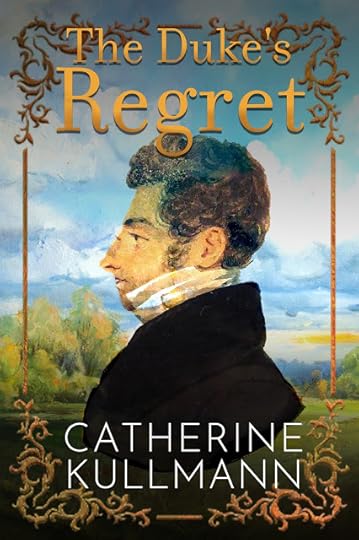
Because The Duke’s Regret contains spoilers for The Murmur of Masks and Perception & Illusion, I have repackaged the three books as The Duchess of Gracechurch Trilogy which is now available as individual eBooks, paperbacks, and an eBook boxed set.

Giveaway
Catherine Kullmann is giving away one paperback copy of“The Murmur of Masks, Book One of The Duchess of Gracechurch Trilogy.”

All you need to do is answer this question:
Carnival is a time of masked celebrations.
If you could visit one famous Carnival would it be Venice, Rio de Janeiro, Cologne, New Orleans of Nice?
Leave your answer in the comments at the bottom of this post.
Giveaway Rules
• Leave your answer in the comments at the bottom of this post.• Giveaway ends at 11:59pm BST on July 19th.You must be 18 or older to enter. • Giveaway is open Internationally.
Start you reading adventure today.You can find all of Catherine Kullmann’s books onAmazon UK • Amazon US
Catherine Kullmann
 Catherine was born and educated in Dublin. Following a three-year courtship conducted mostly by letter, she moved to Germany where she lived for twenty-six years before returning to Ireland. She has worked in the Irish and New Zealand public services and in the private sector. After taking early retirement Catherine was finally able to fulfil her life-long ambition to write.Her novels are set in England during the extended Regency period—that fascinating period between the demise of hoops and the invention of crinolines- the end of the Georgian era but before the stultifying age of Victoria. It was a time of war, revolution and inspiration. The Act of Union between Great Britain and Ireland of 1800, the Anglo-American war of 1812 and more than a decade of war that ended in the final defeat of Napoleon at Waterloo in 1815 are all events that continue to shape our modern world. At the same time, the aristocracy-led society was under attack from those who demanded social and political reform, while the industrial revolution saw the beginning of the transfer of wealth and ultimately power to those who knew how to exploit the new technologies.
Catherine was born and educated in Dublin. Following a three-year courtship conducted mostly by letter, she moved to Germany where she lived for twenty-six years before returning to Ireland. She has worked in the Irish and New Zealand public services and in the private sector. After taking early retirement Catherine was finally able to fulfil her life-long ambition to write.Her novels are set in England during the extended Regency period—that fascinating period between the demise of hoops and the invention of crinolines- the end of the Georgian era but before the stultifying age of Victoria. It was a time of war, revolution and inspiration. The Act of Union between Great Britain and Ireland of 1800, the Anglo-American war of 1812 and more than a decade of war that ended in the final defeat of Napoleon at Waterloo in 1815 are all events that continue to shape our modern world. At the same time, the aristocracy-led society was under attack from those who demanded social and political reform, while the industrial revolution saw the beginning of the transfer of wealth and ultimately power to those who knew how to exploit the new technologies. It was a patriarchal world where women had few or no rights, but they lived and loved and died, making the best lives they could for themselves and their children. And they began to raise their voices, demanding equality and emancipation.
You can find out more about Catherine and her books at: Author's Website • Facebook • Twitter
Published on July 09, 2019 20:00
July 8, 2019
The Island of Tin and King Arthur by Mary Anne Yarde #Arthurian #Legends #Cornwall
The Island of Tin and King Arthur
“The waves were shadows, snakes under a quilt, creeping in almost unseen until they emerged in milky ripples at the water’s edge.”Winston Graham, Ross Poldark.
From the breathtaking beauty of the coast.
 The View from Tintagel Castle
The View from Tintagel CastleTo the enduring Standing Stones whom for thousands of years have sat in watchful silence on Bodmin Moor.
 Hurlers, Bodmin Moor.
Hurlers, Bodmin Moor.Cornwall. A kingdom within a nation. A place where one step can take you on a journey the likes of which you could never imagine. This is a land of wild seas, myths and legends.
In the 6th Century, Cornwall was very much her own nation, just like she had always been. She was separated from the rest of mainland Britain by not only her language and her customs, but also by a spirit that refused to bow down to imposed authority. Whether that be Roman or Saxon.
My series, The Du Lac Chronicles, is set in war-torn South-West Britain, Brittany and Frank. But for today, I am going to talk about Cornwall, or the Kingdom of Cerniw, as she is known in my series.
Cornwall is my secret love affair. If I could choose to live anywhere in the world, it would probably be there. Not only does she have the most staggeringly beautiful countryside and sea, but her history is also something to admire, and her legends… Well, they are just my cup of tea.
 Penhale Sands.
Penhale Sands.Cornwall has an intriguing past. Now we all know that Emperor Hadrian built a huge wall to divide the North of the country from the South because the North was too wild to be conquered. But nothing is ever mentioned about the little kingdom in the far South-West of Britain. The Roman occupation of Cornwall is very intriguing. It has been suggested that the Roman's stopped at Devon. There are a few milestones and evidence of Roman occupation in Cornwall, but not on the scale of the rest of the county. Why? What was it about this little kingdom that stopped even the Roman Empire in its tracks?
Cornwall had something that the Roman’s wanted, and I think they kept their independence because they knew what they were doing when it came to commerce. In fact, Cornwall had something that everyone wanted. Tin. The history of mining for tin in Cornwall goes way back, far before the time of Winston Graham’s Poldarkseries. Cornwall was known as The Island of Tin. Silver has also been found in Cornwall. The land is rich with treasure for those who know where to look. And trade means money, and money… I heard that makes the world go round.
Fast-forward to the time when my books are set in, and once again Cornwall is standing strong against a foreign aggressor. Rome did not best her and nor would the Saxons.
I am fascinated by the Saxon invasion, and it is something that I explore in my series. In particular, I am interested in the Saxon, Cerdic of Wessex, and his journey to being crowned High King. While other kingdoms fell by the wayside and became incorporated into the Wessex realm, Cornwall held her ground. Cerdic landed in Hampshire in c.495. By 519, Cerdic had conquered the South of England, with the exception of Cornwall. It wasn't until the Battle of Hingston Down, in 838, when Cornwall finally lost her independence to the now vast Kingdom of Wessex. Cornwall repelled the Saxons for almost 350 years. Now, that is impressive.
 Dozemary Pool.
Dozemary Pool.As the water settles over Dozemary Pool and when the sun sets over the grass covered ruins of Castle Dore, it is easy to believe in the stories this land inspires. If King Arthur was not born at Tintagel Castle, then he should have been. If Arthur did not fall at Slaughter Bridge, then where did he? This is the land of King Arthur. This is the land where his reign began, and this is the land where it ended. If, you believe the stories that is.
Arthurian Legend and Cornwall have a relationship that spans over a thousand years. My series explores what happened after the death of King Arthur, and therefore Cornwall is a fundamental backdrop to my series.
Travel back to Dark Age Briton with Mary Anne Yarde.
King Arthur had fallen, but his knights are far from dead...
The Du Lac Prophecy
(Book 4 of The Du Lac Chronicles)
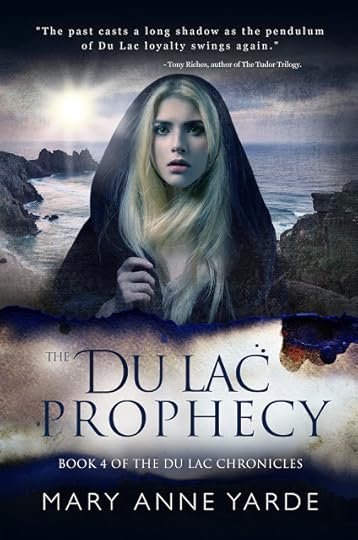
Two Prophesies. Two Noble Households. One Throne.
Distrust and greed threaten to destroy the House of du Lac. Mordred Pendragon strengthens his hold on Brittany and the surrounding kingdoms while Alan, Mordred’s cousin, embarks on a desperate quest to find Arthur’s lost knights. Without the knights and the relics they hold in trust, they cannot defeat Arthur’s only son – but finding the knights is only half of the battle. Convincing them to fight on the side of the Du Lac’s, their sworn enemy, will not be easy.
If Alden, King of Cerniw, cannot bring unity there will be no need for Arthur’s knights. With Budic threatening to invade Alden’s Kingdom, Merton putting love before duty, and Garren disappearing to goodness knows where, what hope does Alden have? If Alden cannot get his House in order, Mordred will destroy them all.
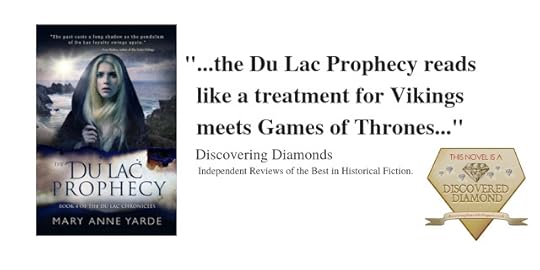
Excerpt
They won’t help you,” Bastian stated and Philippe turned to look at him. “The dead. They won’t help you.”
“I thought I was alone,” Philippe said as he looked back at Tristan’s tombstone.
“In Benwick Castle?” Bastian scoffed. “There is always someone watching. You know that as well as I do. Why are you here?”
“I came looking for answers.”
“Did you find any?” Bastian asked with cynicism.
“No.”
“I didn’t think so.”
“Lancelot was a brave man, wasn’t he?” Philippe mumbled the question more to himself than anything else.
“As was Tristan,” Bastian agreed.
“Did you know him? Tristan, I mean.”
“A little. He kept himself to himself for the most part. He was wounded you see, during the battle of Benwick. He lost the use of his legs. He couldn’t walk. But he...” Bastian smiled as he remembered. “He was very wise. And he was happy to share that wisdom. I liked him. Although not everyone did. After Tristan died, there was talk. Some said he was a liar.”
“What did Lancelot say?” Philippe asked.
“I cannot imagine Lancelot being friends with someone who lied to him. But he neither condemned nor defended Tristan. He kept his own counsel. What are you going to do, Philippe?”
Philippe looked up at the sky. The lavender hue had changed to a blue one. He never appreciated how beautiful the sky was, until now. The day promised to be a warm one, but Philippe felt chilled.
“What would you do?” Philippe asked, as he rose to his feet and looked at his general.
“You have two choices. You can abdicate. Hand him the throne. Or...”
“Or...” Philippe encouraged.
“You could kill him,” Bastian said with a shrug.
Read the multi award-winning series for Free with
 Amazon
AmazonMary Anne Yarde
 Mary Anne Yarde is the multi award-winning author of the International Bestselling Series — The Du Lac Chronicles. Set a generation after the fall of King Arthur, The Du Lac Chronicles takes you on a journey through Dark Age Britain and Brittany, where you will meet new friends and terrifying foes. Based on legends and historical fact, The Du Lac Chronicles is a series not to be missed.
Mary Anne Yarde is the multi award-winning author of the International Bestselling Series — The Du Lac Chronicles. Set a generation after the fall of King Arthur, The Du Lac Chronicles takes you on a journey through Dark Age Britain and Brittany, where you will meet new friends and terrifying foes. Based on legends and historical fact, The Du Lac Chronicles is a series not to be missed.Mary Anne is the founder of The Coffee Pot Book Club. She has been a professional reader since 2016 and in this time Mary Anne has reviewed many books for the big and small publishing houses, as well as books penned by her fellow indie authors. Mary Anne is also an editorial reviewer The Coffee Pot Book Club and for The International Review of Books. Mary Anne has been a judge for a prestigious Historical Fiction Book Award for the last three years, as well as being a Top Reviewer on Netgalley.
Born in Bath, England, Mary Anne Yarde grew up in the southwest of England, surrounded and influenced by centuries of history and mythology. Glastonbury — the fabled Isle of Avalon — was a mere fifteen-minute drive from her home, and tales of King Arthur and his knights were part of her childhood.
You can contact Mary Anne by email:
author@maryanneyarde.com
If you would prefer to chat on social media, then you can find Mary Anne on Twitter and Facebook.
Published on July 08, 2019 23:26
July 7, 2019
Join #HistoricalRomance author, Catherine Meyrick, as she explored what it would have been like to be a 'Sixteenth Century Manor Wife' #History @cameyrick1
‘Seldom doth the husband thrive without leave of his wife’
The Sixteenth Century Manor WifeBy Catherine Meyrick

Sixteenth century conduct manuals advised a man seeking a wife to consider everything from a woman’s age, appearance, health, obedience and piety, to her love of children, singing voice and ability to be silent. Practical skills were not always mentioned; however, Robert Furse (c1539-1593), a Devon farmer, believed that a good wife was more necessary to a well-functioning household than a good husband, so it was important that she was not ‘ignorante how to use and governe thos thynges appertenynge and belongen to her charge’. Depending on the size of the household and a man’s estate, the ‘thynges ... belongen to her charge’ could be vast. With men at all levels often away from home for long periods—at court, at Parliament or on other business—wives not only oversaw the day-to-day running of the domestic household but also their husbands’ rural business enterprises, their estates. The scale of such undertakings is illustrated by the lives of two sixteenth century women, Sabine Johnson and Margaret, Lady Hoby.In 1541 Sabine Saunders (c1520-?) married John Johnson, a draper and wool stapler, in what was, and continued as, a love match. Although Johnson was based in Calais, in 1544 he leased the Old Manor House at Glapthorn, Northamptonshire, and went into the business of wool production, clearing and enclosing land to run sheep. Sabine, as well as producing a child every second year, ran the estate and a household of nearly twenty people in his absence. She employed the domestic staff, paid the bills and kept the accounts. She saw that there was enough to feed the household through the leaner winter months, ensuring that beef was salted, bacon cured, brawn made, and later in the year overseeing the extra baking at shearing time for the shearers and the wool-winders. She directed the seasonal tasks of shearing, sorting fleeces and winding wool as well the threshing and haymaking. She bought cattle and horses, collected tithes and rents and saw to repairs on the barns and the house. Sabine oversaw the tasks of every famer’s wife, large or small – cheese and butter making and egg collecting. Excess grain and surplus domestic produce was sent to market. Frequent guests, both family and friends, also needed to be fed and entertained. And there was the never-ending sewing. While Sabine might not have done the tedious mending, she had to ensure her household and her family were clothed as befitted their station in life and that would have included decoration and embroidery on shirts and smocks.Sabine also had to deal alone with any crises that arose including, in 1548, a dispute over the right to collect tithes that led to a long and costly legal case. When Sabine went ahead and collected the tithes, the minister descended on the manor house, hammering at the front door, demanding them back. She held out but, in the end, the case was found in the minister’s favour and the tithes had to be returned to him.In 1553 Johnson’s business became bankrupt and in 1557 he was imprisoned for two years in the Fleet Prison for debt. Sabine remained at Glapthorn with their children, once again managing alone. On Johnson’s release, the family moved to London where he worked as a secretary to Lord Paget.While the Johnsons were of the middling sort, Margaret Dakins (1571-1633), later Lady Hoby was more highly placed. She was born in 1571, the only child of a wealthy well-connected Yorkshire gentleman, and raised in the household of the Earl and Countess of Huntingdon who were both of strong Puritan leanings. Margaret married three times, the final time to Sir Thomas Posthumous Hoby who was pressing his suit within three months of the death of Margaret’s second husband, despite knowing she had absolutely no wish to remarry. She described herself as ‘nothing but grefe and misery’ in June 1596, two months before her marriage to Hoby. The main reason for her acquiescence to the marriage was the promise of support from Hoby’s influential relatives, such as Lord Burghley, in a property dispute over the Manor of Hackness which had been settled on Margaret at her first marriage.Margaret is best known as the author of the earliest known diary written by a woman in English. Begun as an aid to spiritual discipline, the diary covers six years from 9 August 1599 and records her religious life in detail—prayers, exercises and reading. As the diary progresses Margaret records her domestic life in increasing detail. Unfortunately, she does not touch on her emotions and feelings, matters fascinating to the modern reader for the insights they could give into the workings of a marriage that was not a love match.The household tasks mentioned through the diary give a sense of the rhythm of the household and the range of skills needed by a woman managing such an enterprise. These included preserving both fruit and meat, making sweetmeats and gingerbread, overseeing beehives, candle-making, and ensuring there were sufficient stores. There were seasonal tasks such as ‘pulling hempe’ and weighing and dying wool as well as spinning and winding yard. Margaret kept the household accounts and supervised and paid the servants. Most of her work was done in the company of her women, especially the endless hours spent at needlework, often accompanied by reading from godly books. Margaret tended to the sick and infirm at Hackness, visiting them in their homes, dressing cuts and sores, and assisting poor women in their confinements. She made up medicinal salves as well as distilling oils and aqua vitae. On Sunday she went twice to church and read to a group of old women of the estate; she often spoke to her women and maids about religion and its principles. At Hackness, as in most households of any standing, Margaret had young women in her care learning the skills of household management and piety in the way she had at the Countess of Huntingdon’s. These women included her sister and a cousin as well as several others of good family.Work aside, Margaret played music on her alphorion and sang, spent time in her garden, fished and bowled at the alley on her estate. She drove out in her coach to visit family and friends, as well as having family to stay and neighbours to dinner – necessary, doubtless, because of her husband’s reputation as a humourless puritan* and hunter of recusants in an area of England with lingering Catholic sympathies.Thomas Hoby was frequently away from home about his duties as a member of the Council of the North and of Parliament and Justice of the Peace. In his absence management of the estate fell to Margaret. She oversaw planting, harvesting and sale of wheat, the buying of sheep, planting of trees. She signed leases, received fines and rents, paid the workmen’s wages and kept the estate accounts as well as playing a role in keeping the Manor Court even when Hoby was at home. When he was at home, she discussed management of the estate with him, talking ‘a good time with Mr Hoby of Husbandrie and Houshould matters’.Both Margaret, Lady Hoby, and Sabine Johnson managed their households in relatively peaceful times but in times of tumult women faced great dangers alone, sometimes even holding out against the depredations of over-mighty neighbours or besieging armies. The lives of these women show the close partnership that existed between husband and wife whether the marriage was based on mutual affection or cooler duty. Most certainly neither John Johnson nor Thomas Posthumous Hoby could have ‘thrive[d] without leave of his wife’, as the common saying had it.*Sir Thomas Posthumous Hoby is thought to be the inspiration for the character, Malvolio, in William Shakespeare’s Twelfth Night.
Forsaking All Other
By Catherine Meyrick

England 1585.Bess Stoughton, waiting woman to the well-connected Lady Allingbourne, has discovered that her father is arranging for her to marry an elderly neighbour. Normally obedient Bess rebels and wrests from her father a year to find a husband more to her liking.Edmund Wyard, a taciturn and scarred veteran of England's campaign in Ireland, is attempting to ignore the pressure from his family to find a suitable wife as he prepares to join the Earl of Leicester's army in the Netherlands.Although Bess and Edmund are drawn to each other, they are aware that they can have nothing more than friendship. Bess knows that Edmund's wealth and family connections place him beyond her reach. And Edmund, with his well-honed sense of duty, has never considered that he could follow his own wishes.With England on the brink of war and fear of Catholic plots extending even into Lady Allingbourne's household, time is running out for both of them.
The Coffee Pot Book ClubBook of the Year Award 2018Gold Medal Historical Romance

Read the full review HERE!
Pick up your copy of
Forsaking All Other
Amazon UK • Amazon US
Catherine Meyrick
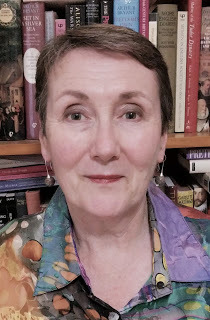 Catherine Meyrick is a writer of historical fiction with a particular love of Elizabethan England. Her stories weave fictional characters into the gaps within the historical record—tales of ordinary people who are very much men and women of their time, yet in so many ways like us today.Although she grew up in regional Victoria, Australia Catherine has lived all her adult life in Melbourne where she works as a librarian. She has a Master of Arts in history and is also a family history obsessive.Catherine’s first novel, Forsaking All Other, was the 2018 Gold Medal winner of The Coffee Pot Book Club Historical Romance Book of the Year. She is currently working on another 16th century novel, The Bridled Tongue, this time set against the threat of immanent invasion by the Spanish in 1588, the Spanish Armada. It touches on issues such as arranged marriages, sibling rivalry and jealousy, the dangers of gossip, and the ways the past can reach out and affect the present. The Bridled Tongue is due out in March 2020.
Catherine Meyrick is a writer of historical fiction with a particular love of Elizabethan England. Her stories weave fictional characters into the gaps within the historical record—tales of ordinary people who are very much men and women of their time, yet in so many ways like us today.Although she grew up in regional Victoria, Australia Catherine has lived all her adult life in Melbourne where she works as a librarian. She has a Master of Arts in history and is also a family history obsessive.Catherine’s first novel, Forsaking All Other, was the 2018 Gold Medal winner of The Coffee Pot Book Club Historical Romance Book of the Year. She is currently working on another 16th century novel, The Bridled Tongue, this time set against the threat of immanent invasion by the Spanish in 1588, the Spanish Armada. It touches on issues such as arranged marriages, sibling rivalry and jealousy, the dangers of gossip, and the ways the past can reach out and affect the present. The Bridled Tongue is due out in March 2020.Connect with Catherine: Website • Facebook • Twitter.
References‘Hoby [néeDakins], Margaret, Lady Hoby’ (bap. 1571, d. 1633), diarist’ Oxford Dictionary of National Biography Oxford University Press, 2013. https://doi.org/10.1093/ref:odnb/37555Moody, Joanna (Editor) The Private Life of an Elizabethan Lady : the Diary of Lady Margaret Hoby, 1599-1605 Sutton, 1998. Appendices include correspondence concerning the courtship of Margaret by Thomas Hoby.Travers, Anita (Ed.) R o bert Furse: a Devon Family Memoir of 1593. Exeter: Devon and Cornwall Record Society, 2012.Winchester, Barbara Tudor Family Portrait London : J. Cape, [1955].Blog post: Early Modern Women—Margaret, Lady Hoby (1571-1633) https://catherinemeyrick.com/2017/08/22/early-modern-women-margaret-lady-hoby-1571-1633/
Published on July 07, 2019 20:00
Find out what inspired #HistoricalFiction author, Nancy Blanton, to write her fabulous book — The Earl in Black Armor #History #Giveaway @nancy_blanton @hfvbt
The Earl in Black Armor
By Nancy Blanton

Ireland, 1635.
When the clan leader sends Faolán Burke to Dublin to spy on Thomas Wentworth, the ruthless Lord Deputy of Ireland, the future of his centuries-old clan rests upon his shoulders. Wentworth is plotting to acquire clan lands of Connacht for an English Protestant plantation. To stop him, Faolán must discover misdeeds that could force King Charles to recall Wentworth to England.
Leaving his young daughter Elvy in the care of his best friend Aengus, Faolán works as a porter in Dublin Castle, and aligns with the alluring Denisa, Wentworth’s personal assistant. She, too, spies on Wentworth, but for very personal reasons.
While Faolán knows he should hate Wentworth, he admires his prosecution of pirates and corrupt nobles who prey on Irish merchants. Supremely arrogant and cruel to his enemies, Wentworth shows loyalty, warmth and compassion for family, friends and a few select others.
A common mission takes Faolán and Denisa from Dublin to London and Hampton Court; to York and Scotland; and to the highest levels of court intrigue and power. But secrets, fears, war and betrayal threaten their love—and even their lives. And as Wentworth’s power grows, so grow the deadly plans of his most treacherous and driven enemies.
Praise for The Earl in Black Armor
“If you are looking for an adventure that will keep you on the edge of your seat, then look no further! Get ready for court intrigue, roguish behavior, and of course, that little bit of romance… Well, then you have a book that is hard to put down.”
Rebecca Hill, Net Galley Reviewer
An Author’s Inspiration…
Contemplating Honor
When I first began to write my latest novel, The Earl in Black Armor, I knew how it had to begin: at Portumna Castle in County Galway. The year 1635, and the moment, when men of honor were being stripped of it by men of greed, for the crime of opposing tyranny.
 Portumna Castle.
Portumna Castle.I also knew the ending of the story, that honor would somehow be realized and rise as the ultimate victor. The hero would teach his daughter the true meaning of honor, the one defining lesson he himself had learned from his father.
And as I write the words now I wonder, wasn’t that a perfect recipe for disaster? And perhaps less so for my protagonist’s journey than for my own journey as a writer? Well, disaster is the wrong word; it turned out to be more of an unanticipated challenge, but certainly it was the greatest one in my writing career so far.
The Earl in Black Armor is a story woven around the last decade in the life of Thomas Wentworth, who would become the first Earl of Strafford during his service as Lord Deputy and later Lord Lieutenant of Ireland for England’s King Charles I. Wentworth believed himself to be a man of honor and piety, but stretched the limits of those concepts in that he felt himself above the law, and believed anything done in the service of an anointed king was not only acceptable, but equivalent to serving God. He believed wholeheartedly in the divine right of kings—that those who ascend to the crown have a God-given right to rule, and receive their guidance and inspiration through direct contact with God.
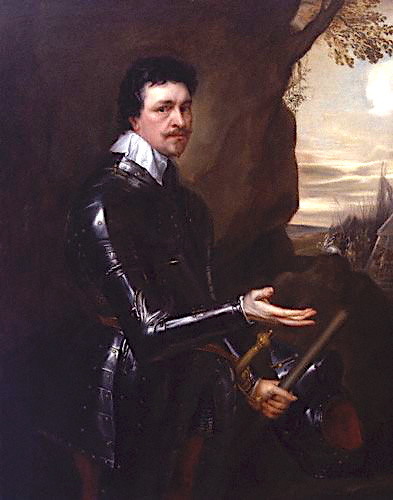 Thomas Wentworth, he first Earl of Strafford.
Thomas Wentworth, he first Earl of Strafford. King Charles I.
King Charles I.My protagonist, Faolán Burke, the only son of a famed and respected warrior, believes it is his birthright to ascend to nobility on the basis of his father’s achievements and reputation. Times had changed since the claim upon Ireland by Henry VIII and his daughter Elizabeth I, and inheritance was not a certainty. Faolán’s inherited lands have been distributed to another, and the English are scooping up the best clan properties for English plantations. Faolán seeks the respect and standing he believes are his due, and will do almost anything—within his own concept of honor—to get it. That includes spying on Wentworth to find cause for the king to remove him from office.
Then comes his co-conspirator, Denisa Dumalin, who spies on Wentworth for her own reasons, and whose sense of honor revolves entirely around her own and her young son’s survival.
The story is rife with conflict in a time when moral codes and traditions are in question. Should all codes of life come from the church? If so, then which church? Protestant, Catholic, Puritan? Does divine right actually exist or, as some of the greatest thinkers are starting to propose, do human beings truly have the ability to reason and guide their own behavior and destiny?
My research of honor was inconclusive. Most writings I found were comparative rather than informative. In 17th century England, honor mostly derives from the 10 Commandments and church doctrine. Is honor just about knowing the difference between right and wrong? Is it self-respect and respect for others? Is it about maintaining a spirit of endeavor? Is it faith in God? Faithful obedience to some inner guide, like ‘the force’? Or is it simply the avoidance of shame?
I sought help from a friend who fit my own construct of an honorable man. Retired after 20 years in the U.S. Navy, most of his service was distant, sometimes covert, and often dangerous. I’m impressed by his calm manner of speaking, his direct and honest gaze, and his steadfast, loving care and gentle but firm discipline for his two daughters who adore him. How would hedefine honor?
“It’s just something you know. It comes early. I’ve seen toddlers peer over their shoulder when they are considering doing something wrong. They just know,” he said.
Had he ever talked about honor with his daughters? I asked. He had not, but in the interest of my research he decided to discuss it over dinner just to see what might come of it.
“We had quite an interesting conversation,” he told me later. “I’ll sum it up and send you an email.”
I waited eagerly, but the email didn’t come, and after two gentle reminders, still nothing came. I thought it best not to ask again—perhaps I was intruding. My own sense of honor wanted to respect their privacy, but I was disappointed.
And then one day I realized that without speaking or writing, he’d already given me the answers. I’d had them for some time. Maybe honor is something we define individually, from learning, observation and experience, and yes, from something internal but unknowable. It cannot be borrowed, and it cannot be taught except in a very limited way.
Likewise, Faolán’s conversation with his questioning six-year-old daughter came to its own form:
Excerpt
From Ch.65
“What is a last resort?”
“It is when you have asked me every question you can think of but can’t get the answer you need, so you ask just one more.”
“What question is that?”
Faolán sighed. “Will it be honor, or will you be havin’ defeat? And sometimes, they are one and the same.”
“I don’t know what that means.”
“It means that when you are traveling down a road and you must choose whether to go this way or that, you should look into the distance to see which way is brighter. You must always choose the brightest, most honorable direction.”
“But,” Elvy sighed with frustration, “what does honorable mean?”
“It means not being selfish or wasteful. You are honorable when you are doing something good for someone though they may not even ask you and though it may not be what you want. It is doing what you think is right—even though others may knock you down for it. Having honor means following that feeling inside that guides your choices by squeezing your heart or twisting your gut.”
She gaped at him, perhaps amazed by all his words but not yet comprehending. He shook his head. He was a foolish, foolish fool.
Was it honorable that he had stayed in London for Strafford? The man he should have hated? Should he not feel good and proud for it then, instead of sick inside? Was it dishonor that he felt sorrow for the man though his ruthlessness so damaged the clan and had killed Martin Darcy? Was it honor or dishonor that he’d spied upon the man while pretending to work for him and that the information he’d provided to Clanricarde likely helped bring Strafford to his death? How could he teach his daughter about honor when he hardly understood it himself?
“Forgive me, sweet. It’s a difficult thing to understand. Let’s forget it for now. Tomorrow we’ll go for a ride on Dunerayl and pretend that we are brave warriors out for an adventure.”
“I will be a warrior, Da. Like you.”“Nay, not like me, aye? Be better than me…”
Giveaway
During the Blog Tour, one winner will receive a signed hardcover copy of The Earl in Black Armor! To enter, click HERE!
Giveaway Rules
• Giveaway ends at 11:59 pm EST on July 19th. You must be 18 or older to enter.
• Giveaway is open to the US & UK only.
• Only one entry per household.
• All giveaway entrants agree to be honest and not cheat the systems; any suspicion of fraud is decided upon by blog/site owner and the sponsor, and entrants may be disqualified at our discretion.
• The winner has 48 hours to claim prize or a new winner is chosen.
Pick up your copy of
The Earl in Black Armor
AMAZON
BARNES AND NOBLE
INDIEB
Nancy Blanton
 Nancy Blanton writes award-winning novels based in 17th century Irish history. Her latest, The Earl in Black Armor, tells a relentless story of loyalty, honor and betrayal in the Stuart era prior to the great Irish Rebellion of 1641. The Prince of Glencurragh, her second novel, occurs in 1634 during the English Plantation of Ireland. Her first novel, Sharavogue, is set in Ireland and the West Indies during the time of Oliver Cromwell. In non-fiction, Brand Yourself Royally in 8 Simple Steps is also a medalist, providing a valuable personal branding guide for authors, artists, and business consultants. Her blog, My Lady’s Closet, focuses on writing, books, historical fiction, research and travel. Ms. Blanton is a member of the Historical Novel Society and is proud to be an occasional guest author on the award-winning UK blog, Myths, Legends, Books & Coffee Pots. She has worked as a journalist, magazine editor, corporate communications leader and brand manager. Her books celebrate her love of history and her Irish and English heritage. She lives in Florida.
Nancy Blanton writes award-winning novels based in 17th century Irish history. Her latest, The Earl in Black Armor, tells a relentless story of loyalty, honor and betrayal in the Stuart era prior to the great Irish Rebellion of 1641. The Prince of Glencurragh, her second novel, occurs in 1634 during the English Plantation of Ireland. Her first novel, Sharavogue, is set in Ireland and the West Indies during the time of Oliver Cromwell. In non-fiction, Brand Yourself Royally in 8 Simple Steps is also a medalist, providing a valuable personal branding guide for authors, artists, and business consultants. Her blog, My Lady’s Closet, focuses on writing, books, historical fiction, research and travel. Ms. Blanton is a member of the Historical Novel Society and is proud to be an occasional guest author on the award-winning UK blog, Myths, Legends, Books & Coffee Pots. She has worked as a journalist, magazine editor, corporate communications leader and brand manager. Her books celebrate her love of history and her Irish and English heritage. She lives in Florida.Connect with NancyWEBSITE • FACEBOOK • TWITTER • GOODREADS

Published on July 07, 2019 19:00
July 5, 2019
#BookReview — Severed Knot by Cryssa Bazos #HistoricalFiction #HistoricalRomance @CryssaBazos

Severed KnotBy Cryssa Bazos

Barbados 1652.
In the aftermath of the English Civil War, the vanquished are uprooted and scattered to the ends of the earth.
When marauding English soldiers descend on Mairead O’Coneill’s family farm, she is sold into indentured servitude. After surviving a harrowing voyage, the young Irish woman is auctioned off to a Barbados sugar plantation where she is thrust into a hostile world of depravation and heartbreak. Though stripped of her freedom, Mairead refuses to surrender her dignity.
Scottish prisoner of war Iain Johnstone has descended into hell. Under a blazing sun thousands of miles from home, he endures forced indentured labour in the unforgiving cane fields. As Iain plots his escape to save his men, his loyalties are tested by his yearning for Mairead and his desire to protect her.
With their future stolen, Mairead and Iain discover passion and freedom in each other’s arms. Until one fateful night, a dramatic chain of events turns them into fugitives.
Together they fight to survive; together they are determined to escape.

“Barbados. Call it hell and be done with it…”
They had been so convinced that they would take the enemy unaware. There was 16,000 of them. More than enough, or so they had thought. But Cromwell… He had foreseen everything, and now, Scotland was burning.
It would have been better if they had all died that day in the fields of Worcester. The alternative was a cold, damp cell riddle with diseases. But even that was better than being chained and dumped in a cargo hold while the ship rolled and danced a nauseating tune on the waves. Worse still, was being sold not for money but eight hundred pounds of sugar. It is true what they say; there are things worse than death.
They had not done anything wrong. They were women for goodness sake. The English soldiers had rounded them up like animals, branded them and then harried them onto a ship. This could not be happening. And yet, it was.
Ian Johnson had promised to stay with his men, his battalion, no matter what. He had also vowed to his men that he would find a way for them to escape the bonds of servitude and return to their beloved Scotland. However, he had no idea how he was going to make good on such a sacred promise.
Freedom had once meant snatching an hour to herself to play the violin. Now the word took on a whole new meaning. As the ship carried her farther away from her beloved Ireland, Mairead O’Coneill swore that one day she would return. After all, indentured servitude wasn’t a sentence for life. It would be hard, but they would survive. However, their future was bleak, for what else were women good for but the whorehouse? If they are ever to feel the soft rain of Ireland again on their faces, then they must learn to endure what is unendurable.
Filled with hatred and resentment, the last thing Ian wanted was to feel anything for the mousey young woman who had been sold to the same wealthy sugar plantation owners as he had. And yet, there was something about Mairead. Spared the whorehouse, she is put to work in the sugarcane fields. Ian unwittingly finds in Mairead a soothing balm to his tortured soul. She is his blessing. But she is also his curse, for there is no way he is leaving her at Mount Vale, regardless of what his men might say on the matter.
If they were to escape, then they would do so together...
From the cold, vermin-filled stinking cell in Tothill Fields Prison and the fir-scented mountain air of An Gallbhaie to the life of a slave at Mount Vale in Barbados, Severed Knot by Cryssa Bazos is the enthralling and unforgettable story of Ian and Mairead as they desperately try to cling to life in the face of unimaginable torment.
Severed Knot is one of those books that stays with you long after you have finished reading it. This is truly an unforgettable story. I thought Bazos’ debut novel, Traitor’s Knot, was fabulous, so fabulous that I awarded it The Coffee Pot Book Club Book Of The Year Award, 2017, but Severed Knot has surpassed all my expectations. Severed Knot is incredibly ambitious, tautly gripping, and an absolute triumph. I was totally blown away by this book. Bazos has penned not only a story with impressive sweep and brilliance, but one that mesmerises from the opening sentence until that last full stop. Severed Knot is a rare treasure indeed.
When one looks upon a man as he does a mule or a donkey, then the world has undoubtedly lost its way. Somewhere in the region of 8,000 to 10,000 Scottish prisoners were deported to New England, Bermuda and the West Indies to work as indentured servants to wealthy landowners. The conditions and treatment of indentured servants in the 17th century are often overshadowed by the horrors of the African slave trade. For those who are not familiar with the term, an indentured servant was one who signed a contract in which they agreed to work for a certain amount of time for free, and therefore calling these men and women “slaves” sometimes comes across as controversial especially when compared with the appalling treatment of the African slaves. However, Bazos asks a question that I think many historians who have studied this era have also asked, and that is, did 8,000+ Scottish prisoners willingly sign such a contract? Bazos explores the highly likely possibility that these prisoners did not even see such a contract, let alone sign it. They were slaves, be it temporary, and their treatment was appalling. If they survived the journey, they then had to endure the working conditions and illnesses such as Yellow Fever. All feared being transported to Barbados. Due to the harsh climate and cruel working conditions, Barbados was nothing short of a death sentence. Many of the Scottish prisoners who had the misfortune of being transported to Barbados never came home. Bazos has captured the horrors that awaited them in Barbados. Ian and his men are forced to work in the relentless heat. They are exposed to tropical illness, and on top of all that, there was the harsh and backbreaking work that they had to do on very little nourishment. Bazos has certainly painted a very bleak but incredibly realistic picture of what life on a Barbados plantation was like.
The horrors and the total lack of humanity that both Ian and Mairead face is truly harrowing, although I feared more for Mairead than I did Ian simply because she was a woman. Mairead endures great suffering, and there were moments when I feared she would break, and this is where, as a reader, I was so thankful for Ian’s character. Ian became Mairead's safe anchor in a world that was foreign. Ian is an unlikely protector as his main concern is getting his men home — this is what drives him and keeps him sane. He is a soldier, a brilliant strategist, and he knows that he should not get emotionally involved with Mairead, but he cannot help himself. Their love story set against such a disturbing backdrop made it in a way all the more real in the telling. Their love for each other was beautiful and more importantly, believable.
There are several antagonists in the tale, but I think it was the complete disrespect for human life that left me in tears on more than one occasion. And I am not just talking about the plantation owners and the overseer. Bazos portrays a hierarchy amongst the slaves. Instead of comradeship, as you would expect, there was a pecking order, and some of the slaves were as vile, if not more so, than their masters. But I am sure that this is how it was, and Bazos does not shy away from showing the worst side of human nature. However, Bazos also shows the best side too — the comradeship between Ian and his men. The tender love story between Ian and Mairead. Severed Knot is not just a story etched in despair. It is one in which hope also resides.
Words cannot do adequate justice to how great this book is. The historical detailing has to be commended. Bazos has brought 17th Century Barbados back to life, and her confident research shines through in every paragraph. This book is undoubtedly a real treat for readers who love historical fiction. If ever a book deserved to be made into a movie, it is this one.
I Highly Recommend.
Review by Mary Anne Yarde.The Coffee Pot Book Club.
Pick up your copy ofSevered KnotAmazon UK • Amazon US
Cryssa Bazos
 Cryssa Bazos is an award winning historical fiction author and 17th century enthusiast with a particular interest in the English Civil War. Her debut novel, Traitor's Knot, is published by Endeavour Media and was the Medalist winner of the 2017 New Apple Award (historical fiction), a finalist for the 2018 EPIC eBook Awards (historical romance) and a finalist for the RNA Joan Hessayon Award. Her second novel, The Severed Knot, was long listed for the 2018 HNS New Novel Award and will be released in 2019. The Severed Knot is the story of two people who have been ripped away from their homes in Scotland and Ireland and transported as bondservants thousands of miles away to Colonial Barbados.
Cryssa Bazos is an award winning historical fiction author and 17th century enthusiast with a particular interest in the English Civil War. Her debut novel, Traitor's Knot, is published by Endeavour Media and was the Medalist winner of the 2017 New Apple Award (historical fiction), a finalist for the 2018 EPIC eBook Awards (historical romance) and a finalist for the RNA Joan Hessayon Award. Her second novel, The Severed Knot, was long listed for the 2018 HNS New Novel Award and will be released in 2019. The Severed Knot is the story of two people who have been ripped away from their homes in Scotland and Ireland and transported as bondservants thousands of miles away to Colonial Barbados.Connect with Cryssa:Website • Newsletter • Facebook • Twitter • Instagram
Published on July 05, 2019 21:00
Check out Sarah Dahl's fabulously sensual book — Tales of Freya #HistoricalRomance #Vikings #KindleUnlimited @sarahdahl13
Tales of Freya
Sensual Short Stories
By Sarah Dahl

In this collection of adult bedtime stories, Sarah Dahl pulls back the curtain of history to depict the erotic lives of Viking men and women. Amid the stark landscapes of fjords, forests and snowcapped mountain peaks, her characters search for love and passion. Dahl authentically illuminates the sensual side of a world of battle and plunder in an alluring collection perfect for every lover of gritty Viking romance.
A warrior recovering by a river is drawn into an unforeseen skirmish with a beautiful shield maiden. An enslaved Christian monk is entranced by his captors' pagan allure. A dissatisfied housewife finds that her home holds an unexpected and liberating secret. An injured farmer is captivated by the magic of his irresistible healer ...
In a world of crackling fires and rough landscapes, long winters and bloody raids, the immediacy of life and death ignites undeniable passions. Warriors and monks, healers and housewives - all follow the call of their hearts and bodies to indulge in pleasures that may forever change their lives.
The Coffee Pot Book Club★★★★★ Highly RecommendedRead the full review HERE!

Pick up your copy of
Tales of Freya
Amazon UK • Amazon US
Sarah Dahl
 Sarah Dahl lives on the edge of the rural German Eifel and writes historical fiction (novels and short stories) primarily set in the Viking age. She was an editor in several German publishing houses and managed a translation agency. The magic of writing re-entered her life at UCD Dublin, where she sat in J.R.R. Tolkien’s office every day, while working on the ‘Dictionary of Hiberno-English’. Tolkien’s spirit must have done something to her creative muscles – it sure wasn’t the bland view from his office. She became a full-time writer soon after and still works as an editor, translates, and coaches new authors. She is interested in everyday life in bygone centuries and the human stories that may have occurred behind the hard, historical facts. Connect with Sarah: Website • Newsletter • Facebook • Twitter • Instagram • Goodreads.
Sarah Dahl lives on the edge of the rural German Eifel and writes historical fiction (novels and short stories) primarily set in the Viking age. She was an editor in several German publishing houses and managed a translation agency. The magic of writing re-entered her life at UCD Dublin, where she sat in J.R.R. Tolkien’s office every day, while working on the ‘Dictionary of Hiberno-English’. Tolkien’s spirit must have done something to her creative muscles – it sure wasn’t the bland view from his office. She became a full-time writer soon after and still works as an editor, translates, and coaches new authors. She is interested in everyday life in bygone centuries and the human stories that may have occurred behind the hard, historical facts. Connect with Sarah: Website • Newsletter • Facebook • Twitter • Instagram • Goodreads.
Published on July 05, 2019 07:35
July 4, 2019
Join #HistoricalFiction author, John Holt, is talking about what inspired him to write The Kammersee Affair #Giveaway #WW2 @JohnHoltAuthor
Lake Toplitzsee is located in the Austrian Salzkammergut, the Austrian lake district. It is approximately 718 metres above sea level, approximately 1920 metres long and 388 metres wide, at its widest part. It is one of the deepest lakes in the region, extending down to a depth of 103 metres. The water temperature of the lake is abnormal. Its basic temperature is about 5.8 degrees Centigrade, which is about 1.8 degrees Centigrade warmer than other lakes of this type. The name Toplitzsee probably comes from the Czech word “Teplice" which means "Warm spring."


As the end of the war in Europe drew to a close, orders were given that numerous items, including weapons, documents, and counterfeit money, were to be destroyed. Large quantities, of these items, were subsequently packed into wooden crates, and then placed into the dark murky waters of the lake.
Several hundred documents were destroyed in this way. Torpedoes and crates of ammunition were disposed of in a similar manner. Large quantities of counterfeit money, and the printing presses that produced the forged notes, were also deposited into the lake. Rumours began to spread regarding buried treasures, and hidden gold bullion.

Over the years following the War extensive searches have been carried out, but no gold bullion has ever been discovered.
* * *
In August 2005 I stayed at Lake Grundlsee, a mile or two from Toplitz. This is the background and the inspiration that led to my first novel “The Kammersee Affair”. It is a story of the search for hidden Nazi gold, but it is much more than that. It is the story of two men, an American GI, and an SS Major. It is a story of murder, blackmail and revenge.

The Kammersee Affair

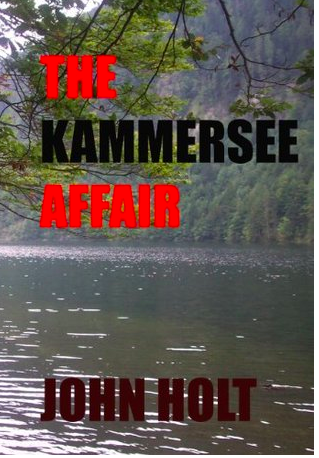
Excerpt
The story begins in the summer of 1955. Two college friends are at the lake.
The lake was flat and calm with barely a ripple. Its dark waters glistened, reflecting the moonlight as though it were a mirror. A myriad of stars shone brightly in a cloudless sky, their shimmering light dancing across the surface of the water. Around the perimeter of the lake were tall conifer trees. Slender, and majestic, they grew, stretching high into the air, competing with each other for the available natural light. Surrounding the lake were sandy, gravely, banks of earth, which extended down to the water’s edge. Beyond, the land gently rose up, the slope gradually growing steeper and steeper, climbing up high along the limestone face to the side of the mountain. In the moonlight the white limestone glowed eerily, contrasting with the blackness of the shadows of the trees.
* * *
A young man sat by the water’s edge. He was in his middle twenties, tall, and slim, with light brown hair. Lying next to him was a discarded oxygen tank, and a diving mask. He sat contemplating the stillness of the lake. A stillness that was momentarily disturbed by a fish as it rose to the surface for air, or to catch an insect. There was no sound, other than the gentle rustle of the trees, and crickets chirping. Or perhaps the gentle lapping of the water as it met the shore. Nearby, a frog croaked, and splashed into the lake. Overhead an owl hooted and then settled down for the night.The young man stared at the water, and thought of the series of dives that he and his friend had made that day. Over the past few days they had gradually worked their way across a section on the northern shore. Today they had been concentrating on a section to the northeast. The area consisted of a large clearing which gently sloped down to the edge of the water. It was reasonably accessible, and looked promising, and they had just started to investigate the area that day. They had achieved a depth of twenty metres, down to one of the shallower shelves that lined the perimeter of the lake. Even at that depth it was still quite dark. Visibility was made even more difficult by the swirling undercurrents stirring the sediment in the lake.
Fritz Marschall knew that neither he, nor his friend, should really have been there. They, like many others before them, had been attracted to the lake by the many rumours that had been circulating. They had been drawn to the area by tales of hidden treasure, and buried gold. They were only rumours, and there wasn’t an ounce of proof, or a shred of evidence to back it up. But still the rumours persisted, and the attraction was still irresistible.
Giveaway
John Holt is giving away three audio copy of The Kammersee Affair.
*ebook copies for International Winners.
• All giveaway entrants agree to be honest and not cheat the systems; any suspect of fraud is decided upon by blog/site owner and the sponsor, and entrants may be disqualified at our discretion.
Pick up your copy of
The Kammersee Affair
Amazon UK • Amazon US • Barnes and Noble • iTunes
 I was born in Bishops Stortford, Hertfordshire, during World War 2. Clearly the world had a lot to contend with at that time, so my coming offered some welcome relief. Whether I had a major influence, or it was pure coincidence, I shall never know, but the war ended shortly after my birth. I have always been a half glass full kind of person, and I’m quite positive in my approach to life. I was brought up on a diet of Rock ‘n’ roll, and only two TV channels. How did we ever manage I wonder? Programmes like Bilko, and Tony Hancock helped I guess, and probably accounts for my sense of humour. As a youngster I wanted to become a doctor, however there was problem, a major problem. I hated the sight of blood, so eventually I became a land surveyor, and spent 24 years working in local government. I then set up in private practice, carrying out property surveys, and preparing architectural drawings. I guess, like a lot of people I had always wanted to write. In fact for several years I used to write articles for a couple of blues magazines (sadly no longer in operation). But I wanted to write a novel.
I was born in Bishops Stortford, Hertfordshire, during World War 2. Clearly the world had a lot to contend with at that time, so my coming offered some welcome relief. Whether I had a major influence, or it was pure coincidence, I shall never know, but the war ended shortly after my birth. I have always been a half glass full kind of person, and I’m quite positive in my approach to life. I was brought up on a diet of Rock ‘n’ roll, and only two TV channels. How did we ever manage I wonder? Programmes like Bilko, and Tony Hancock helped I guess, and probably accounts for my sense of humour. As a youngster I wanted to become a doctor, however there was problem, a major problem. I hated the sight of blood, so eventually I became a land surveyor, and spent 24 years working in local government. I then set up in private practice, carrying out property surveys, and preparing architectural drawings. I guess, like a lot of people I had always wanted to write. In fact for several years I used to write articles for a couple of blues magazines (sadly no longer in operation). But I wanted to write a novel.
Published on July 04, 2019 23:00
July 3, 2019
Join Ann Richardson as she takes a look what it was like to live with AIDS or HIV in the dark days of the 1990s @CelebratingGran

Living with AIDS or HIV in the dark days of the 1990sBy Ann Richardson
Myths? Definitely not. Legends? No. Books? Yes, for certain. And a very powerful one at that.
I am not a historian or a even a writer of historical fiction. I write books that are not easily squeezed into any genre. They are sometimes called ‘narrative non-fiction’, but I don’t much like the term. They are based on interviews with people talking about their lives and are best described as like a TV documentary, but in words.
So what does this have to do with history? Well, if you live long enough, what you lived through when you were younger becomes ‘contemporary history’. And nearly thirty years ago, in the early 1990s, there was a very real crisis in the lives of millions of people across the world – the rise and spread of HIV/AIDS.
Now, so many years later, this is seen to be almost like any other chronic disease, with those diagnosed being able to expect a normal life span. Back then, it was a different story. Seen as a kind of twentieth century plague, it had everyone terrified. For the individual afflicted, it caused a lot of pain and other physical and mental problems, followed by almost certain death. There was no cure.
Because of the stigma attached to the disease, people avoided talking about it. It was thought to be caught, primarily, from the transmission of bodily fluids via blood or sperm, but many lived in fear of accidental contagion.
And the data were frightening: millions died over a short number of years – not just in faraway places, but nearby. It took an enormous toll of mostly young people. Even writing about it now makes me tremble slightly.
Wise Before their Time is a book about a small number of people living with AIDS, who happened to be attending an international conference in London in 1991. It is based on interviews with 21 people – and written material submitted by 23 others – spanning every continent. It allows them to tell their stories in their own words. I felt the statistics being spouted at the time were so overwhelming, there was a need to see the human side.
These men and women talk about how they first learned of their diagnosis, the difficulties of telling their partners, friends and family and the problems of keeping in work and active. Indeed, they explore the many challenges of living with a stigmatising condition, often with numerous friends in the same situation and knowing that they did not have long to live. For the most part, perhaps in part because many were active in their local communities, they were immensely dignified and strong, hence the title of the book.
Sir Ian McKellen kindly offered to write a Foreword, in which he wrote that these stories were “as powerful as any great classic of fiction”. But the power rests, in part, from the fact that it is not fiction. It is all true. Readers will come away with the real understanding of what it was like to live through this terrible time in living memory.
How did I come to write the book? My day-to-day job was a researcher and writer on health issues – and this brought me in touch with many problems of the day. In 1989, I met Dietmar Bolle, a young (early thirties) gay German man, who had been living with AIDS for five years and was a busy AIDS activist. We had little in common (I was in my early fifties, happily married and not an activist at all), but somehow in the way that can sometimes happen, we became close friends.
At that time, I had no particular interest in AIDS – nor, indeed, in issues surrounding dying, although I subsequently wrote another book about people providing end-of-life care (Life in a Hospice). But when I learned that Dietmar was the principal organiser of a conference – and had asked those attending to send in their ‘stories’ with their application, I was hooked.
I immediately saw that this could be lead to a load of fascinating stories, especially if supplemented by personal interviews. Here were people living with the most feared disease of the day, all coming together to talk and learn. It would be a challenge to undertake and would prove a valuable way to humanise this dreadful condition.
Wise Before their Time is the result. Published by HarperCollins in 1992 (Dietmar did not live to see it), it sold well at the time, but eventually fell by the wayside. I took back the rights from the publisher and re-launched it with a new cover and short introduction in 2017, primarily for its historical interest.
Here is one story, to give the flavour. As with the rest of the book, it is written in the present tense, but one has to assume that Danny died within a short time after the interview – along with others I tried to trace some years later.
Danny
Danny is thirty-two and from Northern Ireland. He is currently unemployed, having just spent four years at college studying theology. He had hoped to be ordained as an Anglican priest, but his ordination was deferred on grounds of his homosexuality. He is now seeking to have this decision overturned. He lives on his own.Danny's diagnosis is very recent:I was diagnosed HIV on the 13th December 1990. The reason I went was I'd got a swollen gland under my armpit. I discovered that at Easter of last year and it was still there in December. When they took the test, it was a week's wait. Those seven days were like an eternity.I remember it exactly, probably always will. The doctor said to me, 'As you know, Danny, we took some blood.' I said, 'Yes, I was here when you took it.' And he said, 'Well, we had the results back and I'm very sorry to tell you that it's highly probable that you are positive.' It was as if somebody kicked me in the balls. Then I thought, hang on, what do you mean 'highly probable'? This was my body we were talking about. It took me three times saying I wanted to know what's going on before he said, 'Okay, Danny, the results of the first test are positive.' Although I'd more or less convinced myself that it was possible I was positive, it didn't really prepare me for hearing those words. I'd lived in hope that the result of the test would be negative. I went with a friend, a close woman friend, for the results. I went out and got her and the poor woman, she knew right away what had been said. We sat and talked to the doctor. Or she talked and I just gazed into oblivion. I went back to her place that night, to her and her partner. I intended to get totally drunk, but no matter how many drinks I downed, I couldn't quite make that stage. Who? Why? What's going to happen? Who can I tell? Why me? And even, 'Hang on a second, they got my test mixed up with somebody else. That's what it is, some other poor sod has been told he's negative and in fact he's positive.' And I thought, no, get a grip on yourself, that doesn't happen. My health has been fine. I'm healthier now than I have been for the last two years. The chances are that I'd been living with HIV for at least two years, as my weight had dropped then, over three stone in four months. I did go for a test at that time – and that proved negative. They said to come back in three months, because I had put myself at risk, but I was so relieved I didn't bother going back. One difficult aspect of learning about HIV is telling other people – friends, partners, parents and so forth:The first people I told was the faculty at my college, because they were people I trusted. They'd seen me through the ordination being put off and stood by me. We disagreed very strongly, theologically, with God's view of sexuality, but that didn't matter. When I needed their support they were there. They were fantastic. I couldn't have wished for more from anyone, both faculty and fellow students. When I was first diagnosed, I was in a relationship with another bloke. We'd been together for a number of months. And although we practised safe sex, the first thought that came into my head was have I put him at risk? He wasn't around for a few weeks. When I eventually told him, all he did was get up and just hold me for about twenty minutes, which was fantastic. We're no longer together. I don't think it was anything to do with the HIV, but it might have been. The important thing for me was his immediate reaction – wanting to support and comfort and hold me. He didn't get himself tested. He saw the health advisor and as a result decided that there was no call for him to be tested. I haven't told my mother and brothers. The three of them know that I'm gay – they've known since I was nineteen. That caused enough problems in itself. I went home this Easter, not really sure whether I was going to tell or not. I was only there for a week. And when it came to the Wednesday and I hadn't told them, I thought no – thinking about my mother particularly – to dump this on her now and just leave would be an awful thing to do.It's a difficult thing. What I don't want to happen is that in three years time I become ill with something like pneumonia and end up in hospital. I don't want my mother to find out that way. That would be horrendous for her. But if I tell her now and then go on for the next ten years being healthy, will she spend those years in fear and trepidation?In two or three years time, I'll be ready. I'll know when it's time for me to tell. I want to tell her. It will send her up the wall, it will be as if things are caving in on her. After that, there would be, I hope, a tremendous amount of support. There was a situation about three years ago where my brother wouldn't let me see his kids. That tore me apart. I'd arranged to meet him at his home, to be there for the evening. I met him in the middle of the road and he said his wife didn't want me near the kids, she's afraid of AIDS. He said, 'You're a queer, queers get AIDS, don't they.' I left him, went into town and just got totally wrecked. I was in tears. One effect of telling people is that relationships change:Some of my close friends suddenly wanted to wrap me up in cotton wool. It was as if I became some china doll that had to be treated gently.I was known at college as being one of the more controversial figures. I revelled in that. I'd be forever challenging people about issues to do with unemployment or race or sexuality. I loved getting into heated arguments at times. Two people in particular, I noticed that their whole tone towards me changed, they wanted to 'care for' me. I didn't need to be cared for in that way. I said, 'Listen, I'm still Danny, I'm not "Danny-HIV-positive", I'm Danny.'On one level, it was good to know their desire to shield me from other people's ignorance and fear. On another level, I'm a fighter, born into the civil rights movement in Ireland and brought up with protest almost running in my veins. It was the possibility that that part of me could have been lost. They became like the parent and I became the child. But I was able to say, 'Hang on a minute, I'm still me.' I still enjoy stirring things, I've spent my life breaking out of closets and I'm not about to be shut into another closet called HIV.I'm now involved in a number of training groups. And I'll say 'Listen, if I as a person with HIV get up your nose, then bloody well tell me.' If you begin treating someone as if they're breakable, then you're in danger of robbing them of some of their humanity. There is always a fear of prejudice:I get paranoid on occasion, I think I overhear or see the odd kind of look, as if people are talking about me, people who I'm not close to particularly. I refuse to keep my HIV status under lock and key. I'm not broadcasting it from the rooftop, but one of the things about HIV and AIDS is the stigma and the loneliness and isolation. I used to run a playschool. I really love kids. Often, the mums would be a bit harassed and they'd say, 'Here Danny, take this little so-and-so off me hands.' And I'd take the child and look after them, while mum went for a walk. Which I loved. Sometimes, when the kids were coming through, before they'd get from A to B they would have to crawl all over Uncle Danny. You'd see me crawling under the tables chasing the kids.One day, just after my diagnosis, I was doing that with one little kid and the thought hit me – how would his parents react if they knew I was HIV-positive? And I froze, it was a horrendous thought. Then I thought, no, I'm not going to let this child suffer. He's used to me chasing him around, he looks forward to it and I enjoy it as well. As for the parents, I don't know how they'd have reacted, because they didn't know. Awhile later, I had an incident with a married couple who I'm very close to. I told the husband I'd been diagnosed HIV-positive. The next day, his wife came with her child around the corner and she said 'Look who's here, Jim' as she did every morning. And Jim came tearing round, 'Danny, Danny, hug', arms in the air. There was nothing out of the ordinary. Just this woman being the same with me as she'd always been. I walked away feeling twelve foot tall.It is most helpful to meet others in the same situation:I can come across as being very outgoing, easy, laid back. And I am, partly. But there have been times when it's almost as if the whole surroundings just freeze. And I'm just left there, feeling like I'm suspended on the end of some rope somewhere. Within the week of being diagnosed, I went into the AIDS centre in my area and saw one of the workers. I told her and she didn't say a word, she got up and came over and held me. That was exactly what I needed. Then I found I was going in there almost every day of the week, just to sit down and have a coffee. And let people in the street walk past – they could be out there, I was in here and I was safe.I asked if I could speak with someone else with HIV. The feeling of relief when I saw this person who had been living with it for at least five years and he was healthy! That was so good, to talk to him. We were in the same boat. He knew what it was like, he had experienced some of the same things and he was enjoying his life. Just the other day, I was asked to speak to someone who had just been diagnosed. That gave me a great feeling of contributing, of helping somebody else, just like this person that I spoke to. Just being there. Danny found he needed to come to terms with himself:When I was first diagnosed, I felt very angry at myself, that I had been stupid enough to pick up HIV. I should have been practising safe sex for at least five years. In one of my counselling sessions, the counsellor piled on top of one another five telephone books. She gave me a piece of wood and said, 'Anger doesn't have to be a negative thing, it can be healing, but only if you express it.' I started to hammer into the telephone books and it was frightening, the rage that was in me. It was directed against me. My feeling about myself has changed. Overall, I like me. I am a wholer person today than I was this time last year. HIV brought out all kinds of issues – things that happened as a child – I've been able to look at them. I like being me. The God I believe in doesn't make mistakes.The Jesus of the gospels and the Jesus of the Church so often seem two different people. Some parts of the Church even go as far as saying that AIDS is a plague sent by God. But those who think that haven't met my God. That's blasphemy, to say that God is a despot, playing germ warfare with sections of humanity, it's blasphemy.I'm going to go ahead with the ordination. Very much so. I've been on the road to ordination for eight years and I'm not about to fold up.
Wise Before Their Time:People with AIDS and HIV talk about their livesBy Ann Richardson
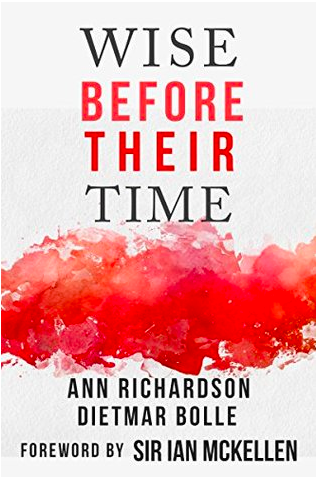
‘This collection of true stories is as powerful as any great classic of fiction’ Sir Ian McKellen.
They are young and they have a life-threatening disease…
The year is 1991. Diagnoses of HIV are rising and there is no cure in sight. Coming from all corners of the world, forty-one young men and women talk about living with HIV and AIDS.
They must cope with the enormous stigma, blame and guilt associated with the disease. And there are challenges in telling their parents and partners, trying to keep healthy and looking for work – all while facing an inevitably shortened future.
Yet they remain committed to celebrating the joys of life as much as they can. The book is testimony to the resilience of the human spirit.
Amazon UK • Amazon US
Ann Richardson
 Ann Richardson spent her working years as a health researcher, undertaking work commissioned by governmental and other agencies to understand people’s experiences of - and views on - their health care. Now retired, she enjoys writing books using her research and writing skills. These books are on all on different subjects: people with HIV/AIDS; people working in end-of-life care and grandmothers, but use the same technique of direct quotation from interviews. A fourth book about the inner thoughts of older men and women is in planning. American by birth, she has lived in London for over fifty years.
Ann Richardson spent her working years as a health researcher, undertaking work commissioned by governmental and other agencies to understand people’s experiences of - and views on - their health care. Now retired, she enjoys writing books using her research and writing skills. These books are on all on different subjects: people with HIV/AIDS; people working in end-of-life care and grandmothers, but use the same technique of direct quotation from interviews. A fourth book about the inner thoughts of older men and women is in planning. American by birth, she has lived in London for over fifty years.Connect with Ann: Website • Facebook• Twitter • Goodreads.
Published on July 03, 2019 23:00
The Coffee Pot Book Club
The Coffee Pot Book Club (formally Myths, Legends, Books, and Coffee Pots) was founded in 2015. Our goal was to create a platform that would help Historical Fiction, Historical Romance and Historical
The Coffee Pot Book Club (formally Myths, Legends, Books, and Coffee Pots) was founded in 2015. Our goal was to create a platform that would help Historical Fiction, Historical Romance and Historical Fantasy authors promote their books and find that sometimes elusive audience. The Coffee Pot Book Club soon became the place for readers to meet new authors (both traditionally published and independently) and discover their fabulous books.
...more
...more
- Mary Anne Yarde's profile
- 159 followers



